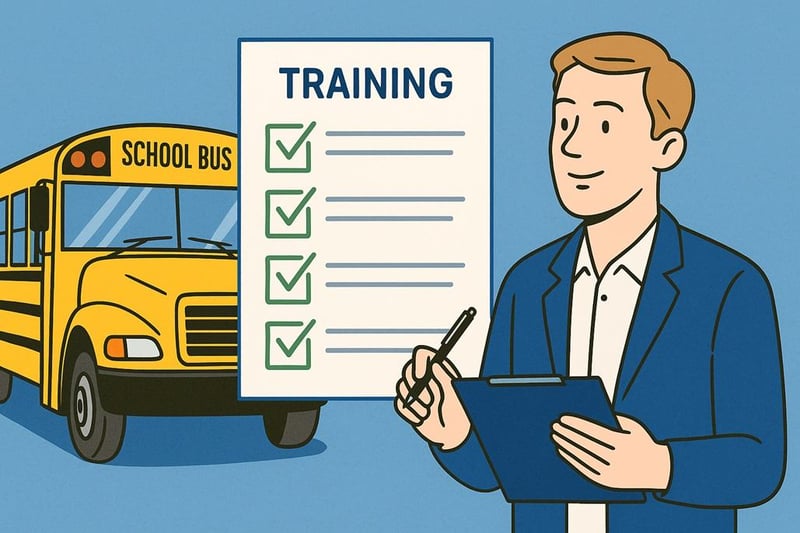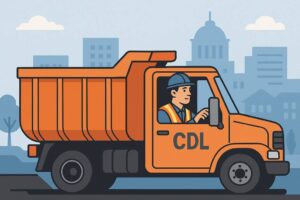Tackling the School Bus Driver Shortage
This guide addresses CDL training for school districts. It is written for K-12 school district administrators, HR departments, and transportation directors seeking sustainable school bus driver shortage solutions. It outlines how to use Driving-Tests.org’s CDL Premium online training platform to establish an in-house onboarding and training program that is ELDT-compliant and can onboard new school bus drivers in as little as 2–4 weeks (instead of the 6–12 weeks using traditional methods).
Background
U.S. school districts struggle with escalating bus driver shortages. According to the National School Transportation Association, in 2023, over 90% of districts reported staffing shortages (in many cases, severe shortages). Stricter FMCSA ELDT requirements implemented in 2022 and a lack of preparedness and training resources for the heightened requirements compounded the crisis. Without enough drivers, districts are forced to combine or cancel routes, causing educational delays for students and placing additional burdens on families and school staff.
Pain Points:
- Severe shortages: Districts often rely on overworked drivers (with multiple assigned routes and absurd pick-up times for students) or administrative staff with CDLs who are pulled from their responsibilities to cover routes.
- Training bottlenecks: Traditional CDL courses can take 6–12 weeks and aren’t always available in certain localities.
- Compliance: FMCSA’s ELDT rules require approved theory and behind-the-wheel training before CDL testing.
Solution: Driving-Tests.org CDL Premium Online Training
Districts are addressing these challenges with Driving-Tests.org’s CDL Premium platform, an FMCSA-approved theory program that supports in-house training models. The platform provides districts with the tools to rapidly train school bus drivers in-house for full licensure while ensuring ELDT school bus compliance.
Platform Benefits:
- Self-paced learning that can be accessed from any online device.
- FMCSA-certified ELDT curricula for Class B CDL, Passenger (P) endorsement, and School Bus (S) endorsement.
- Built-in permit test simulators and state-specific test content.
- Administrator dashboards to track driver progress in real time.
How to Implement Your In-House Training Program:
- Identify Candidate Drivers
Recruit aides, custodians, cafeteria workers, substitute teachers, and local parents. Offer the flexible training support needed to add bus driving to their licensure.
- Enroll Trainees in Driving-Tests.org’s Online Program
Provide immediate access to the CDL Premium course.
- Coordinate Support
Use experienced drivers as mentors during the training process.
- Shorten Timelines
Allow trainees to complete background checks, DOT medical exams, and drug testing while working through the online modules.
- Assist with Licensing
Schedule DMV knowledge exams as soon as drivers are ready. Once they pass, assist them with scheduling the road skills test.
- Track and Report Progress
Monitor ELDT completion through the Driving-Tests.org admin dashboard. Our program can automatically report results to the FMCSA’s Training Provider Registry (TPR) and ensure compliance.
Results
Districts using Driving-Tests.org’s platform have seen dramatic improvements:
- 95% or better permit test pass rate on first try.
- Reduced onboarding time to as little as 2–4 weeks.
- Full ELDT compliance with automated FMCSA TPR reports.
- Current and new staff quickly assume driver roles.
Success story: Meade County Schools in Kentucky cut training time in half using online ELDT theory and their local behind-the-wheel training program. Candidates completed all coursework, passed DMV tests, and obtained CLPs in 3 weeks or less.
Key Takeaways
This guide has shown how Driving-Tests.org’s CDL Premium training can:
- Enable districts to train school bus drivers in-house.
- Maintain full ELDT compliance.
- Quickly solve school bus driver staffing shortage problems.
How Driving-Tests.org Can Help You
- Mobile, Flexible, Self-Paced: Accessible from home or school, it accommodates varied schedules.
- Administrator Oversight: See exactly how each trainee is progressing.
- High Retention, Fast Results: Online preparation helps learners pass tests confidently and start routes sooner.
- Support for Community-Based Recruitment: Help aides and locals upskill into licensed drivers.
By leveraging this model, districts not only meet compliance requirements but also build a sustainable driver pipeline from within.
Incorporating this platform into your training is beneficial to learners and especially helpful in creating a well-rounded training approach for your employees. It also provides these advantageous features:
- Comprehensive CDL Test Preparation: Access to up-to-date practice tests and study materials aligned with FMCSA guidelines.
- Progress Tracking and Reporting: Easily track each driver’s progress and test results to streamline record-keeping.
- Multi-User Management: Add and remove drivers or training coordinators quickly; keep everyone accountable with assigned modules.
- Engaging Mobile-Friendly Content: Drivers can study on their own schedule, reducing classroom time and improving pass rates.
References
Driving-Tests.org. (n.d.). Case study: Meade County Schools – CDL training success.
Driving-Tests.org. (n.d.). Corporate CDL training platform overview.
Federal Motor Carrier Safety Administration. (n.d.). Entry-Level Driver Training (ELDT) regulations and Training Provider Registry (TPR).
New York State Department of Motor Vehicles. (n.d.). School bus driver requirements and statewide shortage response.
Ohio Department of Education. (2024). Bus Driver Flex Career Path Model.
Ohio School Boards Association. (n.d.). Driver recruitment strategies for school districts.
School Transportation News. (n.d.). Medical and safety requirements for school bus drivers.
Spectrum News. (n.d.). Ken-Ton School District offers free school bus driver training to combat shortages.



